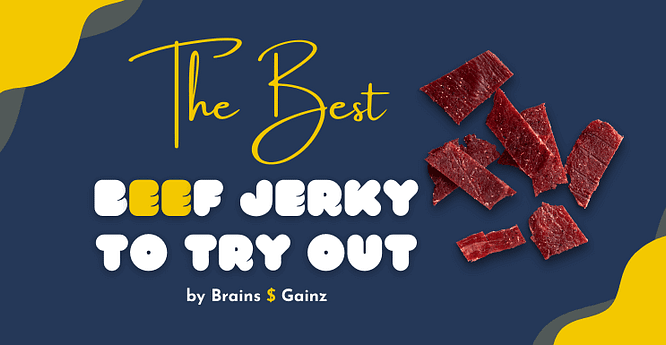When I'm out, whether running or participating in some outdoor activity, I often find myself feeling a little hungry.
Even though I have eaten a meal in the not too distant past, a little extra protein could give me enough calories and some extra energy boost I need.
This is a great time to dig into my stash of Country Archer grass-fed beef jerky because it will satisfy my craving without destroying my low-carb diet.
Given that the term grass-fed is relatively new on the landscape, it makes sense to provide some insider information on why we believe that beef designated grass-fed represents the very best product anyone can get.
The finest in grass-fed jerky comes from cows grazing in pastures with healthy grasses.
These cows must eat a diet that contains none of the additives and antibiotics that can significantly compromise the health and safety of commercial beef products.
At Country Archer Jerky Beef, they are committed to making only the best jerky, not just because it is delicious but also because it is healthy.
The process of making it offers a better experience for the cows as well, establishing a healthy cycle that everyone is sure to appreciate.
I have tried many beef jerky products, but their grass-fed beef jerky products are the most natural tasting so far.
Let's dig some more and talk about why I always keep a pack of grass-fed beef jerky in my backpack.

The Best Beef Jerky Products by Country Archer to Try Out
My Favorite Country Archer Jerky Products
Having discovered beef jerky a few years ago, I usually keep a supply on hand when a little extra energy is needed between meals.
Since there are various flavors, including hickory smoke, teriyaki, sweet jalapeno, and the original, I usually have a least a few choices.
Of course, it is also very convenient that this tasty jerky is available in stick form, bars, and variety packs.
Beef jerky is not only convenient but there is no need for me to worry it will spoil if I leave it in my car or carry it in my pocket all day.
Only 100 percent grass-fed beef is used to make Country Archer beef jerky, and the product does not include any preservatives.
1. Country Archer Jerky, Grass-Fed Beef Jerky, Original
What I Love:
- 100% grass-fed beef.
- Gluten-free, no nitrates/nitrites, no MSG, no hormones or antibiotics.
- High Protein: 80 calories, 10g protein, 0.5g fat per 1oz serving.
The original flavor is incredibly fresh with great taste. One of the best beef jerky I’ve ever tried.
The texture of the original jerky has consistently high-quality flavor, the right texture, and is always fresh and moist.
It has smooth pepper and garlic flavor. I love it.
2. Country Archer Jerky, Grass-Fed Beef Jerky, Teriyaki
What I Love:
- 100% grass-fed beef.
- Gluten-free, no nitrates/nitrites, no MSG, no hormones or antibiotics.
- High Protein: 80 calories, 10g protein, 0.5g fat per 1oz serving.
The teriyaki marinade tastes authentic, made with premium teriyaki beef jerky.
Handcrafted with delicious food ingredients like garlic, pineapple, pepper, and ginger.
Each batch is crafted daily by real people. This Teriyaki beef jerky has a nice mild, sweet flavor. The taste is not overwhelming.
3. Country Archer Jerky, Grass-Fed Beef Jerky, Mango Habanero
What I Love:
- 100% grass-fed beef.
- Gluten-free, no nitrates/nitrites, no MSG, no hormones or antibiotics.
- High Protein: 80 calories, 10g protein, 0.5g fat per 1oz serving.
The Mango Habanero is 100% grass-fed beef jerky.
Mango habanero has a fantastic flavor and delicate balance between sweet and heat.
This jerky is moist, not hard, and easy to chew, with the right thickness. It gives a little kick at the end!
Country Archer Jerky Ingredients and Description
- Excellent source of protein
- Low in fat
- No preservatives added
- No nitrites
- No MSG**
- Natural smoke flavoring added
- Only grass-fed beef used
- Gluten-free
- U.S. inspected and passed by Department of Agriculture EST. 20131
- Crafted premium beef
What Is Corn-Fed Beef?
The name tells the story here, as corn-fed beef is obtained from cows that eat diets rich in corn.
The reason that corn is a popular feed choice for cattle is that it is high in calories and quickly facilitates the fattening of livestock.
Highly caloric diets combined with commercial growth hormones cause swift growth in cattle.
However, speed does not always equate with quality, and we sincerely hope corn-based diets begin to lose popularity due to the potential health dangers to those who ultimately consume the meat.
How Do Corn-Based and Grass-Based Diets Impact Cows Health?
A corn-based diet differs significantly from one based on grass because the former has much greater density, and the feeding environment required differs from the grass-fed environment.
It has been said that a good analogy for this is to consider the difference between eating plates of spinach or kale all day and eating bowls of heavy oatmeal laden with hormone additives and antibiotic drugs.
A cow is almost sure to add weight faster on a corn diet, boosting the ability of meat producers to increase their volumes.
As such, corn has become the popular diet for commercial beef enterprises. But, this is not where the analysis should end.
Cows that are given corn-based diets tend to remain in smaller feeding facilities because the entire purpose of feeding corn is to eliminate the need for expanses of the pasture while achieving rapid weight gain.
The ethical trouble with this type of scenario is apparent. Stowing many large animals in a confined space is cruel and makes for a factory-like production model.
Animals subjected to this type of atmosphere and the humans who eventually eat their meat suffer tremendously as a result.
When pastures are absent, cows get virtually no exercise. Therefore, they grow fatter quickly but do so in an unhealthy way.
Conditions in a typical feedlot are appalling, and animals do not command much respect or consideration.
Corn-based diets are merely a link in a much longer chain that results in the poor treatment of animals in the pursuit of larger profits.
What Are the Health Benefits of Grass-Fed Beef for Athletes?
The reasons why grass-fed beef surpasses corn-fed products are innumerable. Grass-fed cows spend their days traversing the pasture, moving their muscles and producing leaner end products.
Lean meat contains a greater ratio of healthy fats, resulting in a better dietary component for humans.
Grass-fed cows are also known to produce meat higher in vitamins, antioxidants, and key minerals.
Cows that eat grass have the opportunity to glean the natural nutrients from the plants, with clover and wild onion among them.
While humans cannot digest these types of plants, cows can, with the help of their complex digestive systems. Beta-carotene is an excellent example of this difference.
An element of vitamin A is known to be in natural grass pigments. However, it does not exist in corn feeds commonly used in commercial beef production settings.
A human needs to strive toward balance in Omega-3 and Omega-6 volumes. It is important to note that Omega-3 can be found at levels three times higher in grass-fed beef as compared to corn-fed.
The bottom line is that cows are what they eat, and humans, in turn, are the beneficiaries if the bovine diet is healthy.
When highly nutritious grasses are switched to dense yet deficient corn feed products, humans miss out on a tremendous number of nutritional benefits that would otherwise occur from grazing and cattle digestion.
What Are the Benefits of Grass-Fed Beef Production for the Society?
Commentators at the Food Revolution have suggested that grass feeding of cattle is akin to a protein factory, only in reverse.
The concept of feeding corn was initially believed to be an effective method of boosting production, but it has brought a host of health hazards to both cattle and humans.
Corn-fed cows are housed in deplorable conditions, and the antibiotic treatments used to facilitate the process are wholly undesirable.
Fortunately, consumers have become more educated on the process. They insist on healthier production methods for the food they eat and more humane conditions for the animals that provide it.
The modern world is characterized by pollution and many other dangers, and it makes sense to eliminate risk wherever possible.
Unfortunately, governmental subsidies have provided support not to too small, grass-feeding farmers but rather to large corn feed production lots.
Some hope can be taken in the fact that in recent years, Confined Animal Feeding Operations have been countered by farmers focusing on grass feeding principles.
Small farmers who emphasize the humane treatment of animals and the production of healthier beef are driving this trend, with consumer preferences also a substantial factor.
Why Grass-Fed Beed Costs More?
While the benefits of grass feeding are many, some negatives also need to be considered.
First of all, grass-fed production costs more, and the end product also does. The pasture space required for this type of cattle raising is expensive.
Factory farming offers savings, which is a significant reason why it took off in the first place.
However, shifts in consumer demand toward healthier food raised ethically have helped turn the tide back toward the way things used to be.
The main thing to remember is that corn feeding of cattle is all about profit, while grass feeding is done to focus on better treatment of animals and the production of a higher quality product for those who consume them.
Diets based on corn, fed to cattle, tend to be replete with hormones and antibiotics. In contrast, grass-fed cattle produce beef full of potassium, calcium, magnesium, vitamin E, and Omega-3 levels that are truly impressive.
We take great pride in producing meat that is delicious, healthy, and of the highest quality.
Country Archer's customers and gratitude for their efforts within the grass-fed community make all the work worthwhile.
Does Country Archer Grass-Fed Beef Jerky Contain Preservatives?
They use natural preservatives in their jerky products, but no nitrites/nitrates or other artificial preservative additives are ever used.
How Long Does the Shelf Life of Jerky Last?
The jerky we produce generally lasts roughly ten months, and every package has an expiration date.
If you open a package and cannot finish it promptly, eating the rest within a week is advisable.
Eating the jerky more quickly ensures it always tastes as fresh as possible.
What Cuts of Meat Are Used to Make the Best Grass-Fed Jerky?
Generally, jerky is produced from the cow's leanest part.
We use a particular area of muscle that demands a bit of work and seasoning to taste great.
Top Round is the name of the cut Country Archer prefer to use for their beef jerky.
What Goes into a 3 Ounce Package of Jerky and What Makes Beef Cost So Much?
Jerky yield tends to be about half of the actual volume of beef used to create it.
For instance, if you have a full pound of beef, only half a pound of jerky can be produced once the drying process is complete.
The entire job of making jerky also includes the steps of beef trimming, marinating the meat, and gradually dehydrating the product over time.
The cows are raised in wide-open pastures to limit the stresses placed on the cattle.
Their diets are comprised only of grasses, which many consumers value greatly.
What Are the Advantages of Grass-Fed Jerky?
Some of the key benefits of grass-fed jerky products are listed below.
- Grass-fed jerky is far healthier than corn-fed beef products.
- Omega 3 acids and vitamin E levels up to three times greater than found in grain-fed cattle.
- Grass-fed meat is valuable in the prevention of diabetes, heart disease, and cancer.
- Beta-carotene is in concentrations ten times higher than in corn-fed beef.
- Grass-fed meat has higher levels of good fats and antioxidants and lower levels of so-called bad fats.
- Grass-fed meat doesn't have hormones, additives, and antibiotic drugs commonly used in commercial beef production.
- Grass-fed meat contains conjugated linoleic acid, something known to retard the growth of cancerous tumors.
Final Thoughts on the Benefits of Grass-Fed Beef Jerky
Let's summarize the benefits of consuming Country Archer grass-fed beef jerky.
- There is little room for debate about the health advantages of grass-fed products over corn-fed beef.
- The end products, including jerky, will be free from gluten and have much higher levels of antioxidants and vitamins crucial to human development and health.
- Country Archer production processes doesn't include the addition of antibiotics, hormonal supplements, or artificially derived preservatives.
- Country Archer's care and concern for creating its jerky are unrivaled and appreciated by those who purchase their beef jerky products.
Related Articles:




